Time-LLM; Time Series Forecasting by Reprogrammming Large Language Models
Contents
- Abstract
- Introduction
- Related Work
- Methodology
- Model structuere
Abstract
NLP.CV vs. TS
-
NLP & CV) single large model can tackle multiple tasks
-
TS) specialized
\(\rightarrow\) Distinct designs for different tasks and applications
Foundation models in TS: has been constrained by data sparsity
TIME-LLM
-
Reprogramming framework to repurpose LLMs for general TS forecasting
( with the backbone language models kept intact )
-
How? by reprogramming the input TS with text prototypes before feeding it into the frozen LLM to align the two modalities.
-
Prompt-as-Prefix (PaP)
- To augment the LLM’s ability to reason with TS data
- Enriches the input context and directs the transformation of reprogrammed input patches.
-
TS patches from the LLM
- Projected to obtain the forecasts
- Excels in both few-shot and zero-shot learning
- https://github.com/KimMeen/Time-LLM
1. Introduction
Pre-trained foundation models
LLMs’ impressive capabilities have inspired their application to TS forecasting
Several desiderata for leveraging LLMs to advance forecasting
- (1) Generalizability.
- Capability for few-shot and zero-shot transfer learning
- Potential for generalizable forecasting across domains without requiring per-task retraining from scratch.
- (2) Data efficiency.
- Ability to perform new tasks with only a few examples.
- Enable forecasting for settings where historical data is limited
- (3) Reasoning.
- Sophisticated reasoning and pattern recognition capabilities
- Allow making highly precise forecasts by leveraging learned higher-level concepts
- (4) Multimodal knowledge.
- Gain more diverse knowledge across modalities like vision, speech, and text
- Enable synergistic forecasting that fuses different data types.
- (5) Easy optimization.
- Applied to forecasting tasks without learning from scratch.
\(\rightarrow\) Offer a promising path to make time series forecasting more general, efficient, synergistic, and accessible compared to current specialized modeling paradigms.
Key point: effective alignment of the modalities of TS & NLP
\(\rightarrow\) Challenging task, because…
Reason 1)
- (NLP) LLMs operate on discrete tokens
- (TS) Inherently continuous.
Reason 2)
- Knowledge and reasoning capabilities to interpret TS patterns are not naturally present within LLMs’ pre-training.
Time-LLM
Reprogramming framework to adapt LLM for TS forecasting while keeping the backbone model intact.
Corer Idea:
- Reprogram the input TS into text prototype representations
Propose Prompt-as-Prefix (PaP)
- To further augment the model’s reasoning about TS concepts
- Enrich the input TS with additional context and providing task instructions in the modality of natural language.
Output of the LLM
- Projected to generate TS forecasts.
Contribution
-
(1) Introduce a novel concept of reprogramming LLM for TS forecasting without altering the pre-trained backbone model.
-
(2) Propose a new framework, Timee-LLM
-
encompasses reprogramming the input tS into text prototype representations
( that are more natural for the LLM )
-
augment the input context with declarative prompts (e.g., domain expert knowledge and task instructions) to guide LLM reasoning.
-
-
(3) SOTA performance in mainstream forecasting tasks
- especially in few-shot and zero-shot scenarios
2. Related Work
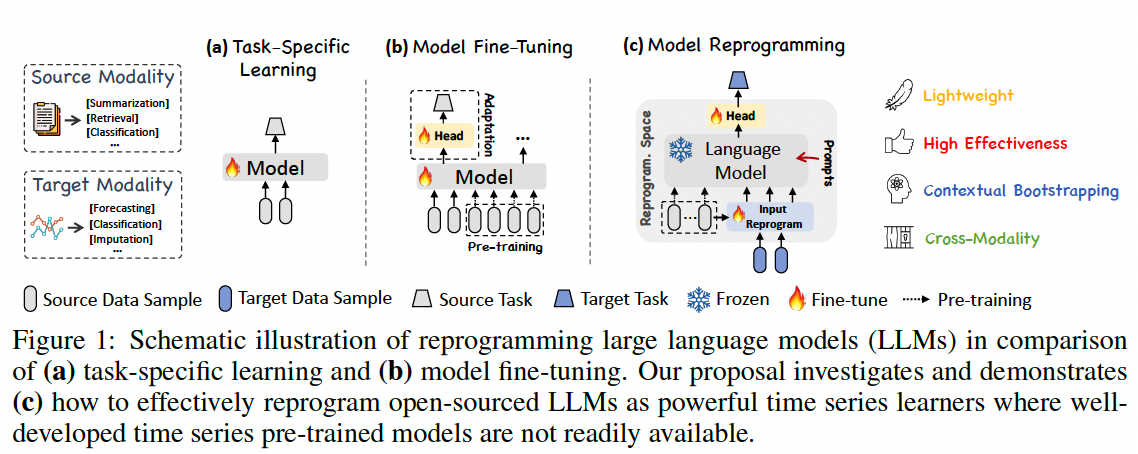
3. Methodology
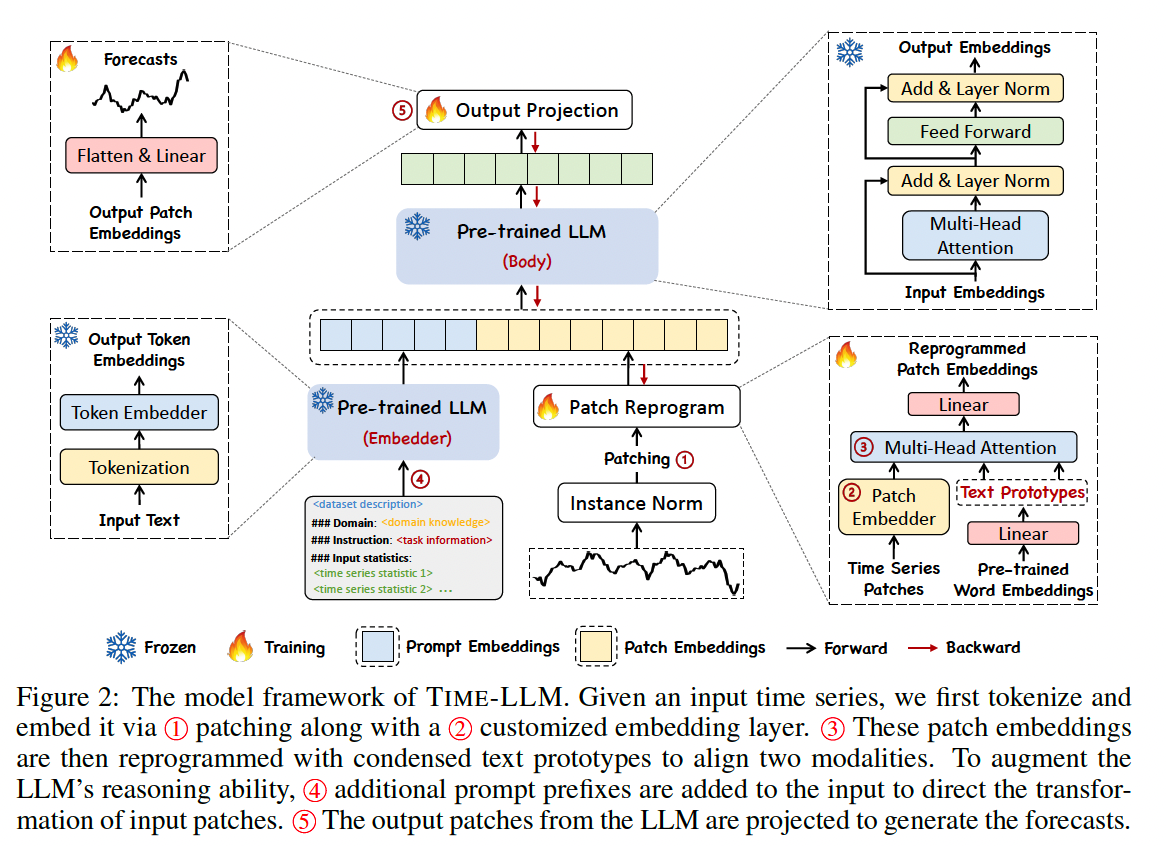
Goal: Reprogram an embedding-visible language foundation model for general time series forecasting without requiring any fine-tuning of the backbone model.
Notation
- Historical observations: \(\mathbf{X} \in \mathbb{R}^{N \times T}\)
- \(N\) different 1-dimensional variables across \(T\) time steps.
- LLM: \(f(\cdot)\)
- Goal: forecast \(H\) future time steps ( = \(\hat{\mathbf{Y}} \in \mathbb{R}^{N \times H}\) )
Loss function: \(\frac{1}{H} \sum_{h=1}^H \mid \mid \hat{\mathbf{Y}}_h-\mathbf{Y}_h \mid \mid _F^2\).
Three main components
- (1) input transformation
- (2) a pre-trained and frozen LLM
- (3) output projection
(Channel Independence) MTS is partitioned into \(N\) UTS! …. \(\mathbf{X}^{(i)} \in \mathbb{R}^{1 \times T}\)
Procedure
- Step 1) Normalization, patching, and embedding ( before being reprogrammed )
- Step 2) Augment the LLM’s TS reasoning ability
- by prompting it together with reprogrammed patches to generate output representations,
- Step 3) Projected to the final forecasts \(\hat{\mathbf{Y}}^{(i)} \in \mathbb{R}^{1 \times H}\).
Efficiency
-
Only the parameters of the lightweight input transformation and output projection are updated
- Directly optimized
- available with only a small set of TS and a few training epochs
- To further reduce memory footprints, various off-the-shelf techniques (e.g., quantization) can be seamlessly integrated
(1) Model Structure
a) Input Embedding
Unit: each input channel \(\mathbf{X}^{(i)}\)
Procedure
- Step 1) RevIN
- Step 2) Patching ( overlapped or non-overlapped ) with length \(L_p\)
- Total number of input patches: \(P=\left\lfloor\frac{\left(T-L_p\right)}{S}\right\rfloor+2\),
- Underlying motivations
- (1) Better preserving local semantic information by aggregating local information into each patch
- (2) Serving as tokenization to form a compact sequence of input tokens, reducing computational burdens.
- Step 3) Embeddding ( with simple linear layer )
- With \(\mathbf{X}_P^{(i)} \in \mathbb{R}^{P \times L_p}\), we embed them as \(\hat{\mathbf{X}}_P^{(i)} \in \mathbb{R}^{P \times d_m}\),
b) Patch Reprogramming
Goal: To align the modalities of TS and natural language to activate the backbone’s TS understanding and reasoning capabilities.
How?
- Reprogram \(\hat{\mathbf{X}}_P^{(i)}\) using pre-trained word embeddings \(\mathbf{E} \in \mathbb{R}^{V \times D}\) in the backbone
- But, no prior knowledge indicating which source tokens are directly relevant!
Simple solution:
- Maintain a small collection of text prototypes by linearly probing \(\mathbf{E}\), denoted as \(\mathbf{E}^{\prime} \in \mathbb{R}^{V^{\prime} \times D}\), where \(V^{\prime} \ll V\).
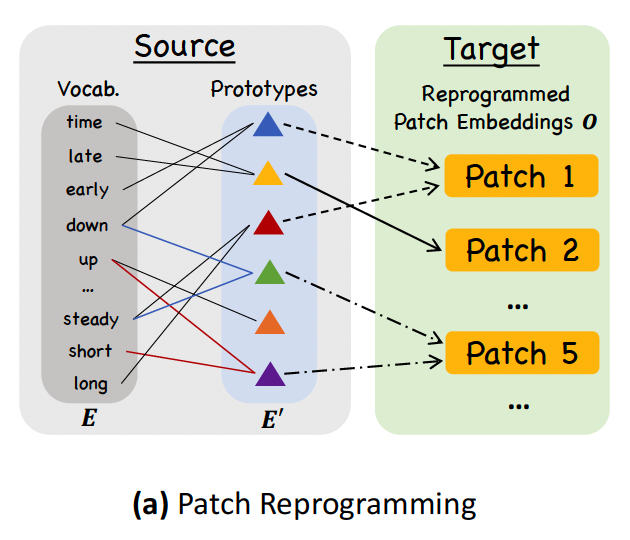
-
Efficient & allows for the adaptive selection of relevant source information
-
Employ a multi-head cross-attention layer
-
Operation to reprogram TS patches in each attention head defined as:
- \(\mathbf{Z}_k^{(i)}=\operatorname{ATTENTION}\left(\mathbf{Q}_k^{(i)}, \mathbf{K}_k^{(i)}, \mathbf{V}_k^{(i)}\right)=\operatorname{SOFTMAX}\left(\frac{\mathbf{Q}_k^{(i)} \mathbf{K}_k^{(i) \top}}{\sqrt{d_k}}\right) \mathbf{V}_k^{(i)}\).
-
Aggregate each \(\mathbf{Z}_k^{(i)} \in \mathbb{R}^{P \times d}\) in every head
\(\rightarrow\) Obtain \(\mathbf{Z}^{(i)} \in \mathbb{R}^{P \times d_m}\).
\(\rightarrow\) Linearly projected to align the hidden dimensions with the backbone model: \(\mathbf{O}^{(i)} \in \mathbb{R}^{P \times D}\).
c) Prompt-as-Prefix
Prompting
- Straightforward & effective approach task-specific activation of LLMs
- Problem) Direct translation of TS into natural language ???
- Recent works) Other data modalities can be seamlessly integrated as the prefixes of prompts,
- Facilitating effective reasoning based on these inputs
Alternative question:
-
Can prompts act as prefixes to enrich the input context and guide the transformation of reprogrammed TS patches?
\(\rightarrow\) Prompt-as-Prefix (PaP)
Prompt-as-Prefix (PaP)
- Significantly enhances the LLM’s adaptability to downstream tasks
- while complementing patch reprogramming
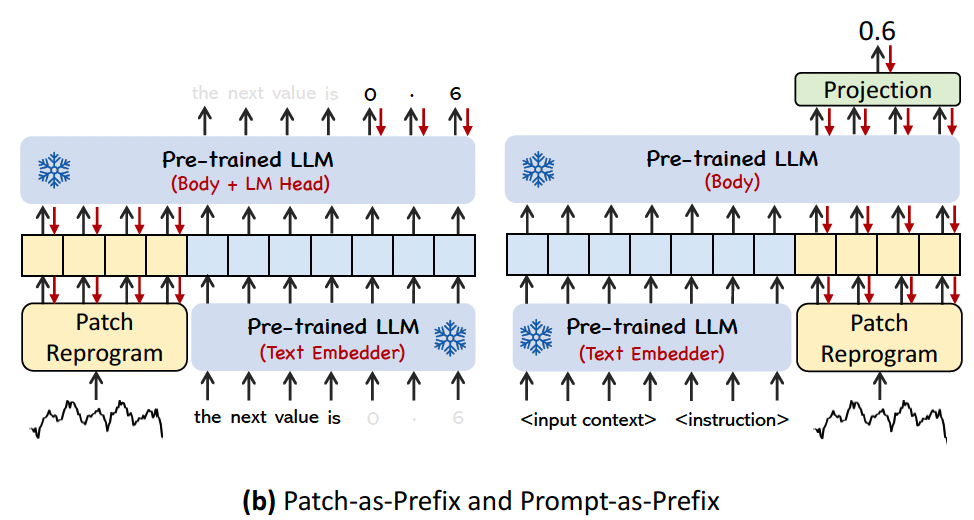
Patch-as-Prefix,
Predict subsequent values in a TS, articulated in natural language
Constraints:
-
(1) LLM typically exhibit reduced sensitivity in processing high-precision numerals without the aid of external tools
\(\rightarrow\) Challenges in accurately addressing practical forecasting tasks over long horizons
-
(2) Intricate, customized post-processing is required for different language models
- Forecasts being represented in disparate natural language formats
- ex) [’ 0 ‘, ‘, ‘, 6 ‘, ‘ 1 ‘] and [’ 0 ‘, ‘, ‘, ‘61’], to denote the decimal 0.61
- Forecasts being represented in disparate natural language formats
Prompt-as-Prefix,
Tactfully avoids these constraints!!!
Identify 3 pivotal components for constructing effective prompts:
- (1) Dataset context
- (2) Task instruction
- (3) Input statistics.
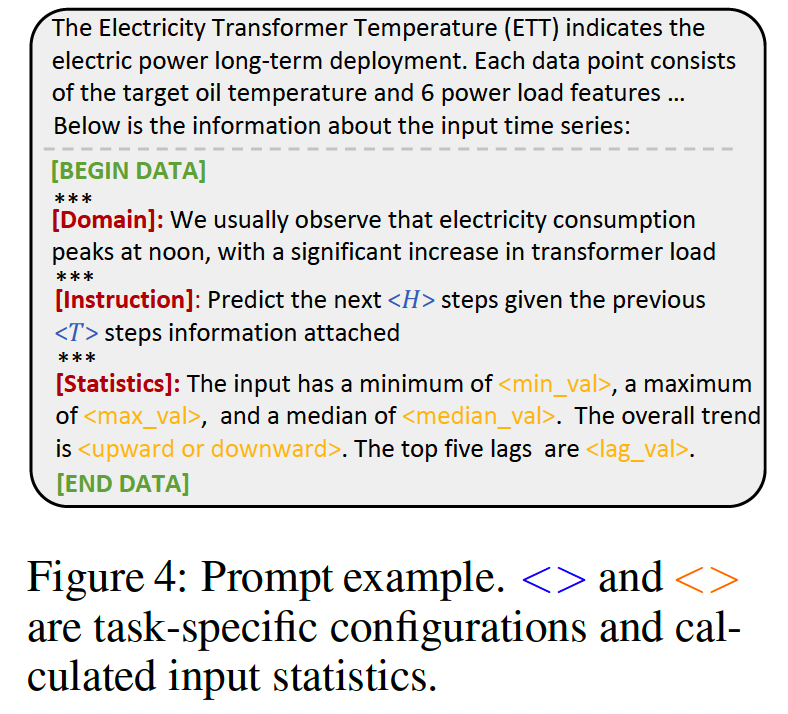
- (1) Dataset context
- Furnishes the LLM with essential background information concerning the input TS
- Exhibits distinct characteristics across various domains
- Furnishes the LLM with essential background information concerning the input TS
- (2) Task instruction
- Serves as a crucial guide for the LLM in the transformation of patch embeddings for specific tasks.
- (3) Input statistics.
- Enrich the input TS with additional crucial statistics
- ex) trends and lags
- Enrich the input TS with additional crucial statistics
d) Output Projection.
Discard the prefixal part and obtain the output representations.
Flatten & linear project them: \(\hat{\mathbf{Y}}^{(i)}\).
4. Experiments
Refer to the paper!
